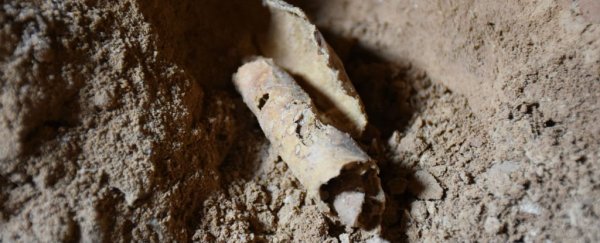A thorough investigation of one of the world's most valuable collections of Dead Sea Scroll fragments has revealed a shocking truth: not one of the collection's 16 fragments analysed is authentic.
The Dead Sea Scrolls, a trove of religious manuscripts containing the oldest known foundations of the Old Testament, date as far back as the third century BCE. The vast majority of these ancient, weathered texts are displayed in Jerusalem, but many more fragments circulate on the private market, where they are coveted by cashed-up collectors and museums.
Unfortunately, many researchers in the field of biblical archaeology suspect that some of these supposed relics – especially a mysterious body of fragments that only turned up late in the day, in 2002 – are cunningly crafted forgeries that can fool even experts.
That bleak view was seemingly confirmed in late 2018, when the US$500 million Museum of the Bible in Washington, DC revealed that at least five of the Dead Sea Scroll fragments in its collection on display were actually fakes.
Since then, the museum has engaged further scientific help to ascertain whether the rest of its scroll fragments (rumoured to have cost millions to acquire) are the real deal. It turns out, rather embarrassingly, they are not.
"After an exhaustive review of all the imaging and scientific analysis results, it is evident that none of the textual fragments in Museum of the Bible's Dead Sea Scroll collection are authentic," says art fraud investigator Colette Loll, the founder and director of Art Fraud Insights.
"Moreover, each exhibits characteristics that suggest they are deliberate forgeries created in the 20th century with the intent to mimic authentic Dead Sea Scroll fragments."
Releasing the results of the analysis in a hefty 212-page report, Loll explains how the 16 fragments in the museum's collections were subjected to a battery of scientific tests, including multispectral and reflectance transformation imaging, traditional and 3D microscopy, microchemical testing, and more.
The upshot is that the fragments analysed showed signs of modern writing inscribed upon archaeological deposits of leather, coated with a protein-based type of animal skin glue, which acted to reinforce the material, while also replicating the surface sheen of authentic Dead Sea Scroll originals, which are written on parchment.
"In all of the fragments that contained writing, we observed examples where modern ink was applied atop preexisting surface deposits and across cracks and areas of delamination already present on the repurposed material," the report explains.
"In some cases, a variety of loose mineral deposits were also scattered over the forgeries after writing, and while the ink was still wet, in order to give the impression that these were authentic Dead Sea Scroll fragments that had come from the Qumran caves. It is our opinion that all of these methods were utilised with an express intent to deceive."
While being duped so publicly is no doubt a galling experience for the Museum of the Bible and its backers – David Green and his family's commercial empire – the organisation is trying to put a brave face in light of the revelations, insisting that their complete transparency over these forgeries will benefit the field of biblical archaeology, by highlighting the crafty techniques used in the creation of fakes.
"Notwithstanding the less than favourable results, we have done what no other institution with post–2002 DSS fragments has done," the museum's chief curator, Jeffrey Kloha, explains.
"The sophisticated and costly methods employed to discover the truth about our collection could be used to shed light on other suspicious fragments and perhaps even be effective in uncovering who is responsible for these forgeries."
The full report on the investigation is available on the Museum of the Bible's website.
